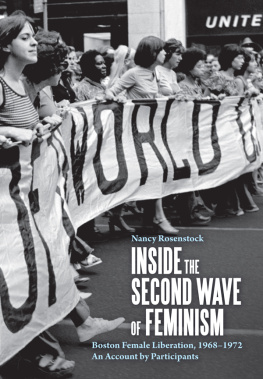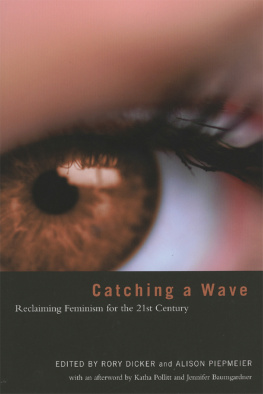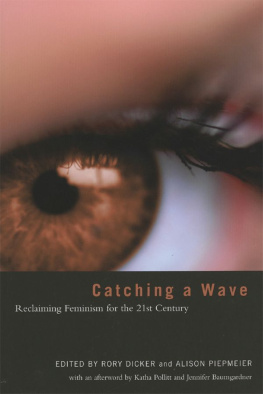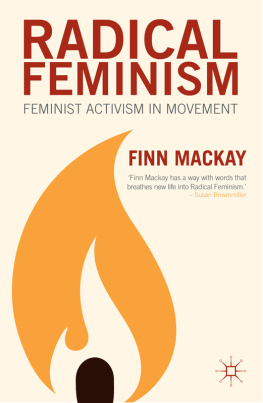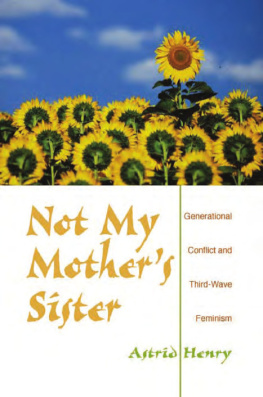Different Wavelengths
Different Wavelengths
Studies of the Contemporary Womens Movement
Edited by
Jo Reger
Published in 2005 by
Routledge
Taylor & Francis Group
711 Third Avenue
New York, NY 10017
Published in Great Britain by
Routledge
Taylor & Francis Group
2 Park Square
Milton Park, Abingdon
Oxon OX14 4RN
2005 by Taylor & Francis Group, LLC
Routledge is an imprint of Taylor & Francis Group
International Standard Book Number-10: 0-415-94878-9 (Hardcover) 0-415-94879-7 (Softcover)
International Standard Book Number-13: 978-0-415-94878-4 (Hardcover) 978-0-415-94879-1 (Softcover)
No part of this book may be reprinted, reproduced, transmitted, or utilized in any form by any electronic, mechanical, or other means, now known or hereafter invented, including photocopying, microfilming, and recording, or in any information storage or retrieval system, without written permission from the publishers.
Trademark Notice: Product or corporate names may be trademarks or registered trademarks, and are used only for identification and explanation without intent to infringe.
Library of Congress Cataloging-in-Publication Data
Different wavelengths : studies of the contemporary women's movement / edited by Jo Reger.
p. cm.
Includes bibliographical references and index.
ISBN 0-415-94878-9 (hardcover : alk. paper) -- ISBN 0-415-94879-7 (pbk. : alk. paper)
1. Feminism--United States. 2. Feminism--United States--History. 3. Feminists--United States. I. Reger, Jo, 1962-
HQ1155.D545 2005
305.42'0973--dc22
2004030630
Visit the Taylor & Francis Web site at http://www.taylorandfrancis.com and the Routledge Web site at http://www.routledge-ny.com
To Faith, who is the future.
CONTENTS
KIMBERLY SPRINGER |
FLORENCE MATITA |
KRISTEN SCHILT |
SALLY HINES |
ASTRID HENRY |
STEPHANIE GILMORE |
SUSANNE BEECHEY |
JO REGER AND LACEY STORY |
BARBARA DUNCAN |
DAWN BATES AND MAUREEN C. McHUGH |
COLLEEN MACK-CANTY |
NANCY A. NAPLES |
EDNIE KAEH GARRISON |
JULIE VOELCK
I am grateful to a number of people who helped with this project. Julie Voelck sparked the idea for this volume by sharing with me the bibliographies she has been compiling on third wave feminism. Julie has been an understanding ear and eye throughout the creation of this volume. Nancy Whittier encouraged me to take on this endeavor, gave me needed feedback, and has served as an intellectual touchstone, mentor, and role model for me throughout my entire academic career. Ilene Kalish, my first editor, got the idea of the book immediately and saw its potential, and I thank her for her enthusiasm. Heather Brewer worked with me to make this manuscript a reality. She always cheered me up when she came to my office.
I also would like to thank my colleagues, Margaret Willard-Traub, Gail McGuire, and Karen Markel for their feedback on various chapters. Abdi Kusow provided needed advice on the process of editing a book. The ideas in the introduction are the result of many stimulating conversations held with friends across the country. In particular, I wish to thank Megan Murphy and Kate Weigand, along with Nancy Whittier and Julie Voelck, in particular for taking time to talk about contemporary feminism and all its issues. I also would like to thank Verta Taylor for graciously moving from being my graduate school advisor to being one of the authors and co-authoring the foreword with Leila Rupp. Many of the questions this book addresses have been raised in her work and the work she has done with Leila.
I end by acknowledging my two best girls. To Faith and Dawn, you make all endeavors worthwhile.
Leila J. Rupp and Verta Taylor
In the mid-1980s, when we were researching and writing Survival in the Doldrums, our study of the U.S. womens movement in the 1950s, we kept trying to think of a metaphor that would describe the process of a small group of elite and aging activists maintaining their commitment to womens rights from the suffrage movement through the years in which mass feminist mobilization receded and there was widespread opposition to feminism. We thought about daffodil bulbs in the winter and the cocoons from which butterflies emerge, but we never did come up with a word that fit those processes. So we went with doldrums, and then later Verta developed the concept of social movement abeyance, delineating the organizational and cultural processes that allowed a submerged network of feminists to continue to fight for gender equality in an inhospitable period.1 We called into question the then prevailing orthodoxy that the U.S. womens movement mobilized through two intense waves of protest and virtually died in the interim years. We argued, instead, for a more continuous view of movements as having thresholds and turning points that scholars had previously mistaken as births and deaths.
At the time, there was no talk yet of a third wave of feminism, and we saw our work as challenging the notion of two waves. But now we think that the wave metaphorwhether ocean waves or radio wavesmay have more utility than we thought, as long as we understand that the lulls between the waves are still moving, that, from a transnational perspective, there may be choppy seas rather than even swells, and that waves do not rise and crash independently of each other. The thoughtful considerations of the wave model in this volume, although not all coming to the same conclusion, contribute to this far more complex vision.
The articles in the brilliantly titled Different Wavelengths move us ahead in our understanding of the contemporary U.S. womens movement and its relationship to what has gone before. The big difference between first wave/second wave and second wave/third wave relationships is that there is plenty of dialogueif not always so civilbetween those from the 1960s generation who identify as second wave and young women who call themselves third wave feminists, in part because less time elapsed between the peaks of activism. One of the big disputes is how diverse the third wave is compared to the second. The authors in this volume, coming from a variety of disciplinary perspectives, attend to racial, ethnic, class, sexual, and gender difference, avoiding simple conclusions about which wave does difference better.
The generational approach to second wave/third wave relations in this volume, characterized by the motherdaughter metaphor, gets at the heart of the sometimes contentious dialogue across periods of white-hot mobilization. We were struck in our own work on the 1950s with how fervently aging feminists longed for young blood, yet how illequipped they were to attract young, not to mention women of color or working-class women, into their ranks. The same was true in the transnational womens organizations in the period between the world wars. Some of their laments about the younger generation sound all too familiar today. U.S. suffragist Anna Howard Shaw in 1910 grumbled to Dutch feminist Aletta Jacobs that it is everywhere the same questionthe young people come into the work with the greatest lack of respect for the older people; they think we have made great blunders all these years and have kept the work back; that now they are going ahead in their sweet and beautiful way.2 Some even foreshadowed complaints about third-wave interest in appearance and new media. One U.S. National Womans Party member in the 1950s found the younger generation hopeless, not interested in anything but cosmetics, T.V. and modern amusements.3


